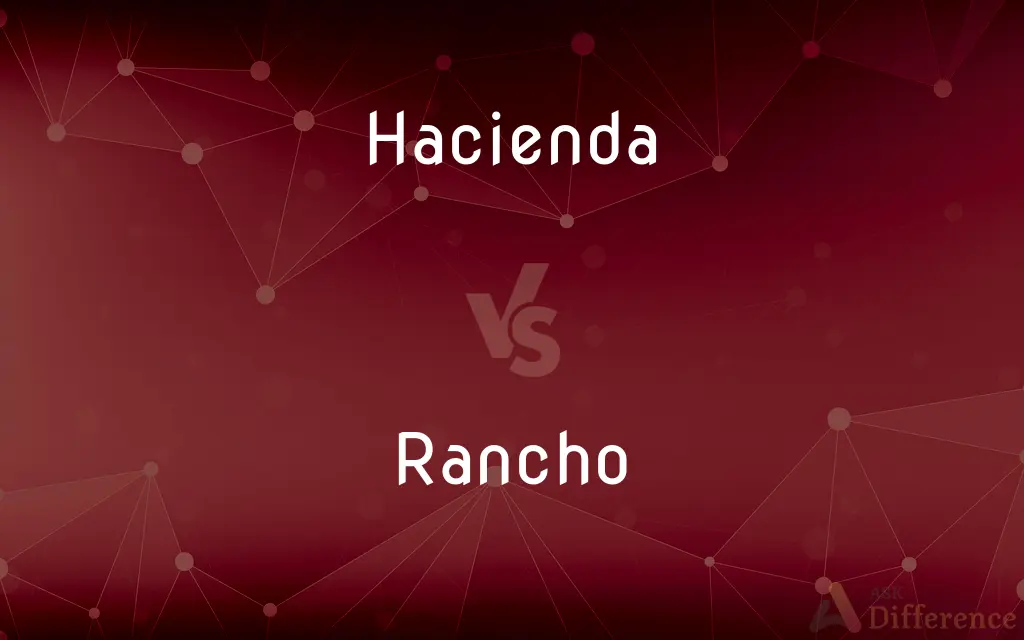Hacienda vs. Rancho — What's the Difference?
By Fiza Rafique & Maham Liaqat — Updated on May 2, 2024
A hacienda generally refers to a large estate or plantation with a dwelling house, while a rancho typically denotes a smaller, more rustic livestock farm.

Difference Between Hacienda and Rancho
Table of Contents
ADVERTISEMENT
Key Differences
A hacienda is often characterized by its substantial size and the comprehensive management of various agricultural activities. On the other hand, a rancho is typically smaller and focuses more narrowly on cattle or sheep ranching.
Historically, haciendas were prominent during the colonial period in Latin America, serving as the centers of agricultural production and local governance. Whereas ranchos were more prevalent in the North American West, symbolizing the cowboy and livestock-centric culture.
Architecturally, haciendas are known for their grand, often elaborate structures which include residential buildings, chapels, and mills. Ranchos, however, usually feature simpler, functional buildings geared towards practicality and livestock management.
In terms of labor, haciendas employed a larger workforce, which could include peasants living on the estate under various forms of peonage. In contrast, ranchos operated with a smaller number of cowboys or vaqueros, emphasizing skills in herding and livestock management.
Economically, haciendas contributed to a broader range of agricultural outputs including crops, dairy products, and meat, supporting local and regional markets. Ranchos were mainly focused on raising livestock for meat and sometimes for hide, influencing the economy in more specialized ways.
ADVERTISEMENT
Comparison Chart
Size
Large estates with extensive land holdings
Smaller, often focused primarily on livestock
Focus
Diverse agricultural production
Primarily livestock ranching
Architecture
Grand and elaborate
Functional and straightforward
Labor
Large workforce, including resident peasants
Smaller teams, often specialized cowboys
Historical Context
Colonial Latin America, integral to local economies
North American West, tied to cowboy culture
Compare with Definitions
Hacienda
A large estate or plantation with residential structures.
The sprawling hacienda housed several generations of the family.
Rancho
A small farm, especially in the Western United States, focused on livestock.
He spent summers working on the family rancho.
Hacienda
A property producing agricultural commodities.
The hacienda produced enough sugar cane to supply the entire region.
Rancho
The dwelling house on such a farm.
The ranch house had been in the family since the 1800s.
Hacienda
In modern usage, often a luxurious residence or resort.
They stayed at a beautiful hacienda converted into a five-star resort.
Rancho
A property used primarily for ranching cattle or sheep.
The rancho was known for its high-quality wool production.
Hacienda
A main house on such an estate, especially in Latin America.
They gathered in the opulent main room of the hacienda.
Rancho
In historical context, associated with the cowboy lifestyle.
Life on the rancho was tough, with long days spent in the saddle.
Hacienda
Historically, a socio-economic system within colonial Spanish territories.
The hacienda system played a crucial role in the region's history.
Rancho
In cultural references, often idealized as a symbol of American rugged individualism.
The film depicted the rancho as a bastion of freedom on the frontier.
Hacienda
A hacienda (UK: or US: ; Spanish: [aˈθjenda] or [aˈsjenda]), in the colonies of the Spanish Empire, is an estate (or finca), similar to a Roman latifundium. Some haciendas were plantations, mines or factories.
Rancho
A hut or group of huts for housing ranch workers.
Hacienda
A large estate in a Spanish-speaking region.
Rancho
A ranch.
Hacienda
The house of the owner of such an estate.
Rancho
A simple hut, as of posts, covered with branches or thatch, where herdsmen or farm workers may lodge at night.
Hacienda
A large homestead in a ranch or estate usually in places where Colonial Spanish culture has had architectural influence.
Rancho
A large grazing farm where horses and cattle are raised; distinguished from hacienda, a cultivated farm or plantation.
Hacienda
A large estate where work of any kind is done, as agriculture, manufacturing, mining, or raising of animals; a cultivated farm, with a good house, in distinction from a farming establishment with rude huts for herdsmen, etc.; - a word used in Spanish-American regions.
Rancho
A rude hut, as of posts, covered with branches or thatch, where herdsmen or farm laborers may live or lodge at night.
Hacienda
The main residence of a hacienda{1}.
Rancho
A large grazing farm where horses and cattle are raised; - distinguished from hacienda, a cultivated farm or plantation.
Hacienda
A large estate in Spanish-speaking countries
Hacienda
The main house on a ranch or large estate
Common Curiosities
How did the labor systems differ between haciendas and ranchos?
Haciendas had complex labor systems often based on peonage, while ranchos typically employed fewer, specialized workers like cowboys.
What architectural styles are associated with haciendas?
Haciendas often feature Spanish colonial styles with large courtyards and elaborate details.
Are ranchos exclusive to the United States?
While closely associated with the American West, the concept of a rancho can be found in other countries, often with local variations.
Can a hacienda also involve livestock farming?
Yes, many haciendas also manage livestock, but their operations usually include a variety of agricultural practices.
What role did haciendas play in the local economy?
Haciendas were pivotal in local economies, often controlling not only agriculture but also the commercial and labor markets in their regions.
How did the workforce differ in terms of living conditions on haciendas and ranchos?
Workers on haciendas often lived on the estate under semi-feudal conditions, whereas ranchos, with their smaller scale, had less formal living arrangements, typically involving seasonal or itinerant labor.
What types of crops were typically grown on haciendas?
Haciendas often grew a variety of crops such as sugar, coffee, corn, and wheat, depending on local conditions and market demands.
What is the main difference between a hacienda and a rancho?
A hacienda is typically a large estate with diverse agricultural activities, whereas a rancho focuses more on livestock ranching.
Did ranchos have any cultural significance in American history?
Yes, ranchos are deeply ingrained in the mythology of the American West, symbolizing independence, the frontier spirit, and the development of the ranching industry.
How did the size of a hacienda compare to that of a rancho?
Haciendas were typically much larger than ranchos, encompassing vast tracts of land suitable for multiple types of agriculture, whereas ranchos were generally smaller and more specialized.
What is the historical origin of the term 'hacienda'?
The term 'hacienda' originates from Spanish colonial law, where it designated large land grants made by the crown, often to colonists in Latin America.
Can the term 'rancho' be used to describe any small farm?
While 'rancho' typically refers to a livestock-oriented farm in the context of the American West, it can colloquially refer to smaller farms in general, though this is less common.
How has the concept of the hacienda evolved in modern times?
In modern times, many haciendas have been transformed into hotels, museums, or venues for social events, preserving their historical architecture and ambiance.
Is there a difference in the legal implications of owning a hacienda versus a rancho?
Historically, owning a hacienda could involve various feudal-like rights and responsibilities, including jurisdictional control over local affairs, unlike owning a rancho, which was typically less politically charged.
Were ranchos ever part of larger estates or haciendas?
In some cases, especially in Latin America, ranchos could be part of a larger hacienda, dedicated specifically to the hacienda’s livestock needs.
Share Your Discovery

Previous Comparison
Hope vs. Hopefully
Next Comparison
Consonant vs. ObstruentAuthor Spotlight
Written by
Fiza RafiqueFiza Rafique is a skilled content writer at AskDifference.com, where she meticulously refines and enhances written pieces. Drawing from her vast editorial expertise, Fiza ensures clarity, accuracy, and precision in every article. Passionate about language, she continually seeks to elevate the quality of content for readers worldwide.
Co-written by
Maham Liaqat















































